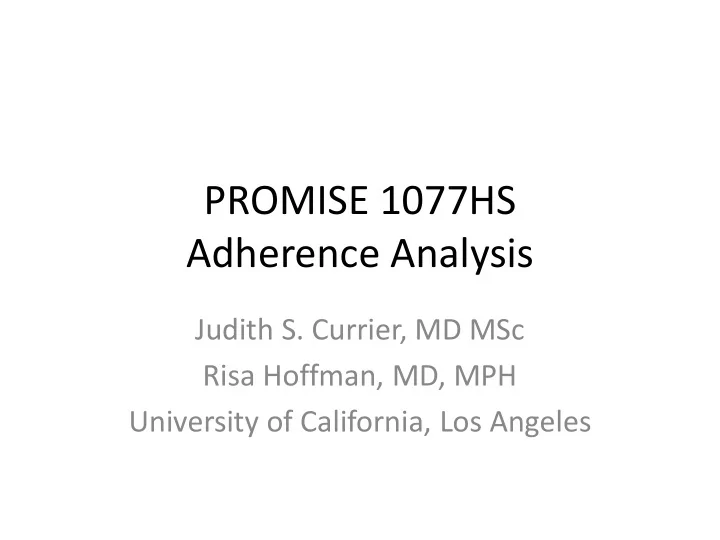

PROMISE 1077HS Adherence Analysis Judith S. Currier, MD MSc Risa Hoffman, MD, MPH University of California, Los Angeles
Background slide • A randomized strategy trial conducted among women who received highly active antiretroviral therapy (ART) during pregnancy for purposes of prevention of mother-to-child transmission (PMTCT) of HIV but do not otherwise meet criteria to initiate HAART for their own health
PROMISE 1077HS • To determine whether continuation of HAART (Arm A) after delivery or other pregnancy outcome reduces morbidity and mortality compared to discontinuation and re-initiation of ART according to current standards of care (Arm B). • The primary combined endpoint includes death, AIDS-defining illness, and serious non- AIDS-defining cardiovascular, renal, and hepatic events.
1077HS Research Question Among women who do Screen not meet criteria for ART for their own Enroll (n=2000) health, who received a R triple ARV (ART) regimen during CONTINUE CONTINUE STOP STOP pregnancy for PMTCT, HAART ART HAART ART is long term health Follow-up until Follow-up until Follow-up until Follow-up until better served by 84 weeks after 84 weeks after 84 weeks after 84 weeks after continuing or stopping last participant last participant last participant last participant randomized randomized randomized randomized ART postpartum?
Primary Adherence Objective • “To evaluate rates of self-reported adherence to ART and its association with the primary endpoint and with CD4+ cell count, HIV- 1 viral load, and HIV-1 resistance patterns at 1, 2, and 3 years following randomization.”
Adherence Objectives • To compare adherence among those in the immediate treatment arm to those in the delayed treatment arm • To compare Quality of Life data between those in the immediate versus delayed ART arms • To determine which components of the QOL/Adherence/Resource use self report form are most predictive of nonadherence • To look at geographic differences in adherence
Additional objective • ~18 months into the study, addition of a detailed adherence questionnaire asking about barriers
Adherence Objectives • Among those with evidence of virologic failure (VL > 1,000 copies) due to nonadherence, to characterize most common barriers • To determine whether barriers vary between those who are adherent and those with episodes of virologic failure • To determine whether barriers vary by geographic region
PROMISE General Overview: Sequential Randomized 2x2 Factorial Trial ~8,000 women who don’t need treatment for own health (CD4 >350) PP for Duration BF After Weaning IP AP 14wk-term R Infant uninfected a Continue at birth n Triple d Drugs o Mother Triple drug R m prophylaxis a Triple drug Triple drug i Stop n prophylaxis prophylaxis z All ARVs Infant NVP d e x 6 wks R o a m Maternal Health n i AZT + d z AZT SD NVP o e Infant daily (7 d TRV) m NVP i z e Antepartum Postpartum
PROMISE 1077BF/FF
PROMISE 1077BF/FF
PROMISE 1077BF/FF
1077BF/FF Adherence Objectives • Antepartum: To evaluate adherence to maternal ARV regimens • Postpartum: To evaluate adherence to maternal and/or infant ARV regimens • Maternal Health: To evaluate rates of self-reported adherence and its association with the primary endpoint, CD4 count, viral load, and resistance patterns 1, 2, and 3 years following randomization • To compare quality of life between study arms at 1, 2, and 3 years • Additional questions on barriers not added to BF/FF
Additional opportunities BF/FF • To compare adherence in those in the maternal health arm among those who continue after cessation of breastfeeding versus those who d/c and restart later for maternal health – Are factors associated with nonadherence different by region (comparison using 1077HS)
Additional opportunities BF/FF • To evaluate adherence at different stages (what factors predict high versus low adherence? What factors are associated with specific patterns of adherence: high on all, low on all, mixed) – Pregnancy – Postpartum up to 3 or 6 months – After cessation of breastfeeding among those who continue for maternal health
DISCUSSION
Recommend
More recommend